For Establishing A General Methodology of Creative Problem-Solving / Task-Achieving
Toru Nakagawa (Osaka Gakuin University, Professor Emeritus)
For Establishing A General Methodology of Creative Problem-Solving / Task-Achieving |
|
| Toru Nakagawa (Osaka Gakuin University, Professor Emeritus) |
|
| Presented at 4th Global TRIZ Conference in Korea, Special Invited Talk, Held on July 9-10, 2013 at Seoul Trade Exhibition& Convention, Seoul, Korea | |
| [Posted: Aug. 28, 2013] |
For going back to Japanese pages, press buttons.
Editor's Note (Toru Nakagawa, Aug. 26, 2013)
This page posts the presentation slides of my Special Invited Talk presented last July at Global TRIZ Conference 2013 in Korea. Slides are also posted in Japanese
. Participation report of GTC2013
has been posted in Japanese .
The contents of this talk is the up-to-date reorganized version of what I have been talking/writing since last year. I recently decided to use 'CrePS' as the abbreviation of the 'General Methodology of Creative Problem-Solving and Task Achieving'.
For making the 45 minutes lecture as comprehensive as possible, I made 35 slides including 10 slides marked with ☆Skip which were talked just briefly. In addition to the PDF versionof the slides, this page shows the slide images in HTML with Table of contents, for readers' convenience.
In next two months I am going to talk about further extensions of this work CrePS: at Japan TRIZ Symposium (Sept. 5-6, 2013, in Tokyo) on how to construct the CrePS methodology; at Japan Creativity Society Conference (Oct. 26-27, in Saitama) and at ETRIA TRIZ Future Conference (Oct. 29-31, in Paris) on the vision of the CrePS methodology. Even though slowly, I am going to build up the contents of the CrePS methodology.
Table of Contents
Introduction Title; Outline of the talk Part 1: Why a new target? motivation Models for learning, mastering, proliferating TRIZ For a person to learn TRIZ; For an engineer and a company to master TRIZ; Overall activities for TRIZ promotion Areas for TRIZ application Perspectives of desirable areas of TRIZ application
Recognition of a new target Recognition of a new higher-level target: CrePS Outline of our evolution path Conventional approaches for creative problem solving Various conventional approaches Reconsidering TRIZ TRIZ methodology for problem solving;
Four-box scheme of problem solving with abstraction;
Various tools of TRIZ in the Four-box scheme; Essence of TRIZApproach with USIT USIT process; USIT Operators for solution generation;
Example of a USIT operator; Example of application of USIT operators;
Solution generalization method of USIT
USIT application example A familiar problem in sewing: Defining the problem;
Understanding the present system; Understanding the real system;
Generating solutions; USIT trainingSix-box scheme Six-box scheme of USIT as a new paradigm for creative problem solving;
Characteristics in the Six-box scheme;
Real World and Thinking World in the Six-box schemeGeneral methodology of creative problem-solving / task-achieving (CrePS)
Outline of the CrePS methodology;
Main part of the CrePS methodology (for technologies);
Overall requirements for the CrePS methodology (for technologies);
Main part of the CrePS methodology (for non-technological areas);
Areas where the CrePS methodology is wanted to applyConcluding remarks Concluding remarks
Presentation Slides: Slides in HTML (this page) Slides in PDF
Slides in Japanese in HTML Slides in Japanese in PDF
Introduction


Part 1. Why a new target ?
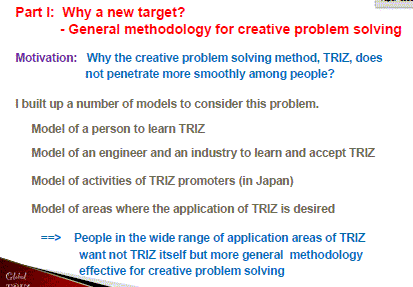





Part 2. How can we evolve from TRIZ to the new target?


Reconsidering TRIZ
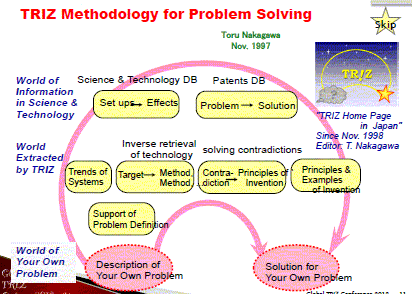
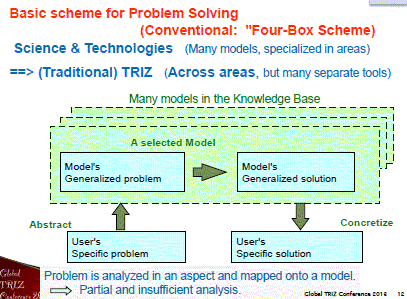


Approaches of USIT

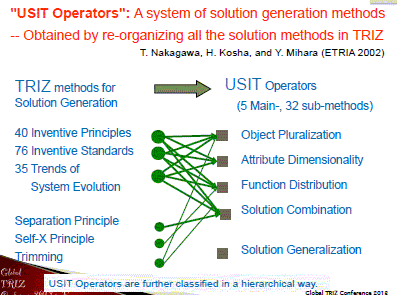



A simple case study of USIT



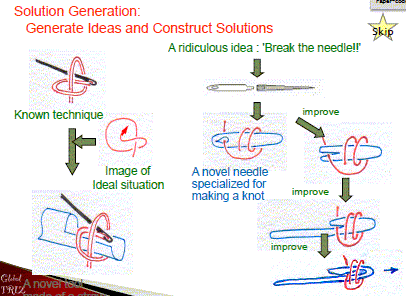

The Six-Box Scheme
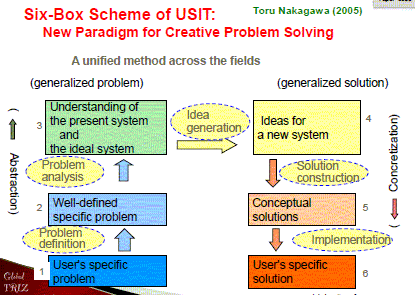


General methodology of creative problem solving / task-achieving (CrePS)




Concluding Remarks

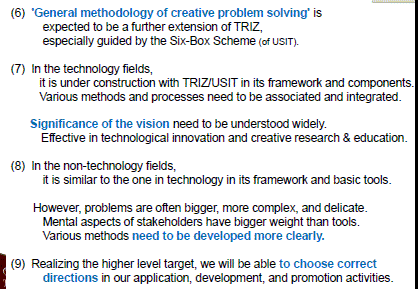

| Top of this page | Top of the slides | Introduction | Part 1: Why a new target? | Part 2: How can we evolve from TRIZ to the new target? | USIT approach | ||
| USIT example | Six-box scheme | Concluding remarks | Slides in Japanese PDF |
GTC2013 Participation report |
Japanese page |
Last updated on Aug.28, 2013. Access point: Editor: nakagawa@ogu.ac.jp